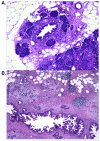Increased Prevalence of Precursor Lesions in Familial Pancreatic Cancer Patients
- PMID: 19996207
- PMCID: PMC2795080
- DOI: 10.1158/1078-0432.CCR-09-0004
Increased Prevalence of Precursor Lesions in Familial Pancreatic Cancer Patients
Abstract
PURPOSE: Histologic findings in 51 pancreata resected from patients with a strong family history of pancreatic cancer were compared with the findings in 40 pancreata resected from patients with sporadic pancreatic cancer. None of the patients in the familial group had a known inherited syndrome other than familial pancreatic cancer. EXPERIMENTAL DESIGN: Precursor lesions, including pancreatic intraepithelial neoplasia (PanIN), intraductal papillary mucinous neoplasm (IPMN), and incipient IPMN, were quantified. Invasive cancers were classified using established histologic criteria. RESULTS: The individual precursor lesions identified in both groups were histologically similar. Precursor lesions were more common in the familial cases than in the sporadic cases. The relative rate of PanINs per square centimeter was 2.75-fold higher (95% confidence interval, 2.05-3.70; adjusted for age) in familial compared with sporadic cases. PanIN-3 lesions were more common in familial versus sporadic pancreatic cancer patients (relative rate, 4.20; 95% confidence interval, 2.22-7.93; adjusted for age). High-grade incipient IPMNs were only observed in the familial cases. Nine of the 51 (18%) familial pancreatic cancers and 4 of the 40 (10%) sporadic cancers arose in association with an IPMN. No significant differences were found in the types of invasive cancers. CONCLUSIONS: Noninvasive precursor lesions are more common in patients with a strong family history of pancreatic cancer than in patients with sporadic disease, and precursor lesions are of a higher grade in patients with a strong family history of pancreatic cancer. These findings can form a basis for the design of screening tests for the early detection of pancreatic neoplasia. (Clin Cancer Res 2009;15(24):7737-43).
Figures



References
-
- Lynch HT. Genetics and pancreatic cancer. Arch Surg. 1994;129:266–8. - PubMed
-
- Petersen GM, de Andrade M, Goggins M, et al. Pancreatic cancer genetic epidemiology consortium. Cancer Epidemiol Biomarkers Prev. 2006;15:704–10. - PubMed
-
- Klein AP, Brune KA, Petersen GM, et al. Prospective risk of pancreatic cancer in familial pancreatic cancer kindreds. Cancer research. 2004;64:2634–8. - PubMed
-
- Lowenfels AB, Maisonneuve P, Cavallini G, et al. Pancreatitis and the risk of pancreatic cancer. International Pancreatitis Study Group. N Engl J Med. 1993;328:1433–7. - PubMed
Grants and funding
LinkOut - more resources
Full Text Sources
Medical

